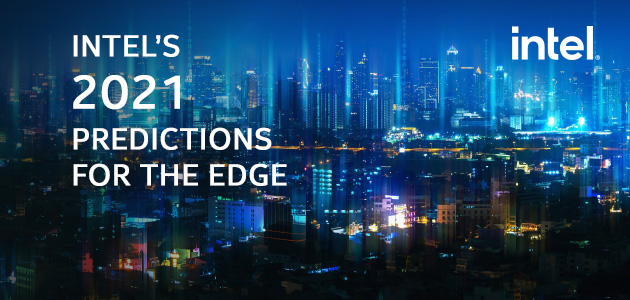Intel’s 2021 Predictions for the Edge
As artificial intelligence becomes more pervasive and networks transform to deliver 5G, Intel’s leaders expect the edge to drive tremendous business value while also improving daily lives.
Here are their predictions

Christine Boles
Vice President, Internet of Things Group, and General Manager, Industrial Solutions Division, Intel
Accelerating industrial transformation: “The pandemic has greatly accelerated the need for companies to complete their Industry 4.0 transformations with solutions that allow them to have more flexibility, visibility and efficiency in their operations. We’ll see an acceleration of adoption of solutions that help address that need, ranging from AI including machine learning, machine vision and advanced analytics. As the economy bounces back, we’ll continue to see investment in the foundational OT infrastructure with more IT capabilities to allow the broad ecosystem of players to deploy these solutions and will see Industry 4.0 adoption significantly ramp up in 2021.”

Rick Echevarria
Vice President, Sales, Marketing, and Communications Group, and General Manager, Olympic Program, Intel
Transforming sports: “In 2021, AI, 5G and edge computing will help athletes improve their athletic performance while transforming the way fans experience their favorite sports in a safe and interactive way, whether virtually, over broadcast or with a safe return to in-person.”

Joe Jensen
Vice President, Internet of Things Group, and General Manager, Retail, Banking, Hospitality & Education, Intel
Rethinking education: “In 2021, shifting to Education-as-a-Service will become a priority, and I expect advances in education policy and investment to drive this concept forward. It will be critical to shift funding and allocations to schools to advance this service model, to ensure that affordable and high-quality education is accessible to all students. Longer-term, Education As-A-Service will become the standard for education across the globe.”
“In the long-term, retailers will continue to reply on seamless, convenient solutions like dark stores to cost effectively serve delivery customers. To be a ‘winner’ in the changing retail space, retailers must transform production methods in creative ways to meet customer expectations.”

Alex Quach
Vice President and General Manager, Wireline and Core Network, Intel
Virtualizing the network: “Virtualization in the core network will hit a tipping point growing from 50%, to more than 80% of core network workloads to be virtualized in 2024, and we also expect the majority of the leading 5G Operators to start 5G standalone Core Deployments in 2021.”

Cristina Rodriguez
Vice President and General Manager, Wireless Access Network Division, Intel
Transforming the network: “With the network transforming at high-speeds, 2021 will see Massive MIMO deployment on vRAN architecture at scale (i.e., beyond trial phase, at thousands of sites).”

Sameer Sharma
General Manager, Smart Cities and Intelligent Transportation, Intel
Making cities smarter: “2021 will be a breakout year for smart and resilient cities, infrastructure and transportation. In the short-term, we’ll see a sharp increase of mid-size cities adopting smart cities technology, which will lead to the democratization of technology outside of the usual tech hubs. Longer-term, smart cities infrastructure will be adopted in more rural areas, as consumers start to see the benefits for quality of life.

Stacey Shulman
Vice President, Internet of Things Group, and General Manager, Health, Life Sciences and Emerging Technologies, Intel
Improving health outcomes: “One of the things that is currently holding the healthcare industry back is standardizing medical records and data sharing across organizations. Collaboration in the medical industry for the purpose of solving illness and health issues can be critical, especially when it comes to public health crises and tracking population health, as we have seen with the pandemic this year.
“In 2021, we will see improvement in the delivery models for information sharing, as emerging technologies such AI and federated learning become more ubiquitous in healthcare. In addition to powering innovations like telehealth, these technologies will accelerate and streamline the collaboration process, making it easier for healthcare professionals to deliver quality care to their patients as well as stay up to date on new treatment options.”
|
|
To get more information |
|



